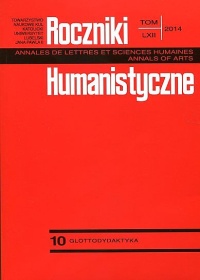Sociolinguistic Factors Influencing the Perception of Non-Native Speech
Abstrakt
Czynniki socjolingwistyczne wpływające na percepcję mowy z obcym akcentem
W artykule zaprezentowano dane empiryczne dotyczące percepcji angielszczyzny Polaków przez trzy grupy rodzinnych użytkowników z Wysp Brytyjskich (Anglików, Irlandczyków i Szkotów). Głównym celem przeprowadzonego badania było sprawdzenie, w jakim stopniu socjolingwistyczny kontekst odbiorcy (płeć, wiek, wykształcenie, stopień osłuchania z angielszczyzną Polaków i częstotliwość kontaktów z Polakami) wpływa na odbiór mowy z obcym akcentem. Sędziowie oceniali dwie próbki dźwiękowe angielszczyzny Polaków pod względem natężenia obcego akcentu i irytacji, którą one wywołują u słuchaczy. Analiza danych pokazała, że wiek i płeć respondentów nie ma wpływu na ocenę powyższych parametrów (zaobserwowane różnice nie są istotne statystycznie). Wykształcenie odbiorców oraz stopnień osłuchania z angielszczyzną Polaków różnicował natomiast ocenę odsłuchiwanych próbek.
Bibliografia
Ben Said, S. (2006): Attitudes towards Accented Speech: A Comparative Study of Native and Non-native Speakers of American English. [M.A. thesis, Southern Illinois University Carbondale, the United States of America] http://www.personal.psu.edu/users/s/b/sbb170/MA%20Thesis.pdf [retrieved August, 2013].
Brodkey, D. (1972): Dictation as a measure of mutual intelligibility: a pilot study, “Language Learning” 22 (2), 203-217.
Cunningham, U. (2008): Acoustic variability in the production of English vowels by native and non-native speakers, in: E. Waniek-Klimczak (ed.), Issues in Accents of English, Cambridge: Cambridge Scholars Publishing, 1-16.
Derwing, T, M.J. Munro and M. Rossiter (2002): Teaching native speakers to listen to foreign-accented speech, “Journal of Multlingual and Multicultural Development” 23, 245-259.
Fayer, J.M. and E. Krasinski (1987): Native and non-native judgments of intelligibility and irritation, “Language Learning” 37 (3), 313-325.
Flege, J.E. (1988): Factors affecting degree of perceived foreign accent in English sentences, “Acoustical Journal of America” 84 (1), 70-79.
Fraser, C. and B. Kelly (2012): Listening between the lines. Social assumptions around foreign accents, “Australian Review of Applied Linguistics” 35 (1), 74-93.
Gass, S. and E.M. Varonis (1982): The comprehensibility of non-native speech, “Studies in Second Language Acquisition” 4 (2), 114-136.
Gonet, W. and G. Pietroń (2004): The Polish tongue in the English ear, in: E. Waniek-Klimczak and W. Sobkowiak (eds.), Zeszyty Naukowe PWSZ w Koninie. Konin: PWSZ, 56-65.
Gynan, S. (1980): Comprehensbility, irritation and error hierarchies, “Hispanica” 68 (1), 160-165.
Lindemann, S. (2010): Who’s ‘unintelligible?’ The perceiver’s role, “Issues in Applied Linguistics” 16 (2), 223-232.
Ludwig, J. (1982): Native-speaker judgments of second language learner’s efforts at communication: a review, “Modern language Journal” 66, 274-283.
Munro, M.J. and T. Derwing (1994): Evaluations of foreign accent in extemporaneous and read material, “Language Testing” 11, 253-266.
Munro, M. J. and T. Derwing (1995): Foreign accent, comprehensibility, and intelligibility in the speech of second language learners, “Language Learning” 45, 73-97.
Munro, M. J. and T. Derwing (2001): Modeling perception of the accentedness and comprehensibility of L2 Speech. The role of speaking rate, “Studies in Second Language Acquisition” 23, 451-468.
Munro, M.J., J.E Flege and I. MacKay (1996): The effects of age on second language learning on the production of English vowels, “Applied Psycholinguistics” 17, 313-334.
Nikolov, M. (2000): The Critical Period Hypothesis reconsidered: Successful adult learners of Hungarian and English, “International Review of Applied Linguistics” 38 (2) 109-124.
Nowacka, M. (2008): Do Students and Native/Non-native Teachers Rate Pronunciation Differently?, in: Robert Kiełtyka, Dorota Osuchowska and Elżbieta Rokosz-Piejko, Language, Literature, Culture and Beyond, Rzeszów: Wydawnictwo Uniwersytetu Rzeszowskiego.
Moyer, A. (2013): Foreign Accent. The Phenomenon of non-native speech, Cambridge: Cambridge University Press.
Majer, J. (2002): “Sick or Seek? Pedagogical Phonology in Teacher Training,” in: Ewa Waniek-Klimczak and Patrick James Melia (eds.), Accents and Speech in Teaching English Phonetics and Phonology, Berlin: Peter Lang.
Piske, T., I. MacKay and J.E. Flege (2001): Factors affecting the degree of foreign accent in an L2: An overview, “Journal of Phonetics” 29, 191-215.
Podberesky, R., R.H. Deluty and S. Feldstein (1990): Evaluations of Spanish- and Oriental-accented English speakers, “Social Behaviour and Personality” 18 (1), 53-63.
Ryan, E.B. (1983): Social psychological mechanisms underlying native speaker evaluations of non-native speech, “Studies in Second Language Acquisition” 5, 148-159.
Schairer, K. (1992): Native speaker reaction to non-native speech, “Modern Language Journal” 76 (3), 309-319.
Sato, K. (1998): Evaluative reactions towards ‘foreign accented’ English speech: The effects of listeners’ experience on their judgements. [M.A. thesis, the University of Alberta, Canada], http://www.collectionscanada.gc.ca/obj/s4/f2/dsk2/ftp04/mq28987.pdf (retrieved June, 2013).
Scheuer, S. (2003): What to teach and what not to teach ? Some reflections on the relative salience of L2 phonetic errors, in: Włodzimierz Sobkowiak and Ewa Waniek-Klimczak (eds.): Zeszyt Naukowy Neofilologii (2), Konin: PWSZ.
Scheuer, S. (2008): Why native speakers are (still) relevant, in: K. Dziubalska-Kołaczyk and J. Przedlacka (eds.), English Pronunciation Models: a Changing Scene: 2nd Edition, Bern: International Academic Publishers, 111-130.
Szpyra-Kozłowska, J. (2005): Intelligibility versus Polish accent in English, “Studia Phonetica Posnaniensia. An International Journal for Linguistic Phonetics” vol. 7, Poznań: Wydawnictwo Naukowe Poznań.
Szpyra-Kozłowska, J. (2013): On the irrelevance of sounds and prosody in foreign-accented speech, in: Ewa Waniek-Klimczak and Linda Shockey (eds.), Teaching and Researching English Accents in Native and Non-native Speakers, Berlin: Springer Berlin Heidelberg.
Tajima, K., R. Port and J. Dalby (1997): Effects of temporal correction on intelligibility of foreign-accented English, “Journal of Phonetics” 25 (1), 1-24.
Thompson, I. (1991): Foreign accents revisited: The English pronunciation of Russian emigrants, “Language Learning” 41 (2), 177-204.
van den Doel, R. (2006): How Friendly are the Natives? An Evaluation of Native-speaker Judgements of Foreign-accented British and American English, Utrecht: Netherlands Graduate School of Linguistics (LOT).
Yuan, J., Y. Y. Jiang and Z. Song (2010): Perception of foreign accent in spontaneous L2 speech. http://www.ling.upenn.edu/~jiahong/publications/c03.pdf (retrieved June, 2013).
Copyright (c) 2014 Roczniki Humanistyczne

Utwór dostępny jest na licencji Creative Commons Uznanie autorstwa – Użycie niekomercyjne – Bez utworów zależnych 4.0 Międzynarodowe.





